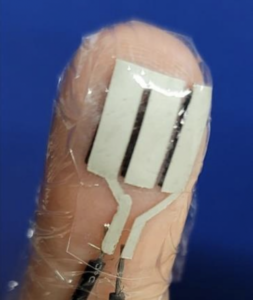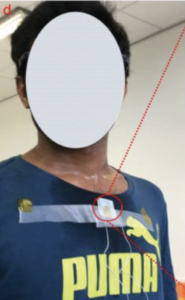Sustainable transitions
Blood, sweat, and engineers have developed electricity free of charge
Energy Transitions By Valentina Bravo

Person running and sweating while using their phone
Unsplash/Quino Al
In the train last weekend, the woman sat in front of me got fined because her phone ran out of battery, and she was unable to show her e-ticket – understandable at 8pm. According to the Volkskrant, oil and gas prices are at an all-time high, so if you have any adult-life living costs, a fine is the last thing you need. A portable charger might come to mind … but wait until you hear about the energy your sweat can produce. Not only would this mean you could stay connected all day, anywhere, but it would also mean electricity free of charge.
Not everything has a price
Lu Yin is an engineer at the University of California San Diego and is currently working on several projects, one of which is a battery that runs on sweat. His day in the life at the lab starts early and unfed as he starves himself till 3pm. Then he finally eats a muffin and drinks a redbull. He does this because one of his projects revolves around measuring blood sugar levels (diabetics need to measure this consistently because their body can’t properly control these levels). Not exactly what you’d expect a scientist’s diet to be like, but as Lu put it, to collect good data for your experiments “you have to do it on someone, and it costs to hire subjects.” Everything in life has a price!
Ironically, another project Lu has had to test on himself was his “Free Energy” project, as he phrased it. This project was the development of a band-aid like patch, as seen in Figure 1, that absorbs sweat and converts it to electricity. Lu and his research partner spent many nights wearing the patch, hooked up to machines that measure the energy production. This is why it is referred to as free energy. “You don’t need to invest anything to get energy from this product,” Lu clarified. And it turns out that in 10 hours of sleep you can harvest enough energy to power an electronic wristwatch for 24 hours, just from the sweat of one fingertip.

Figure 1: The band-aid like patch that Lu Yin created to absorb sweat and convert it to electricity. This is a prototype. Retrieved from his article (linked below).
It’s electrifying!
Just one fingertip? Interestingly, fingertips passively sweat a lot in comparison to other body parts. They’re just ventilated very well, so you might not even notice it, although those with sweaty hands probably think otherwise. Sweaty fingertips are actually the reason everyone leaves fingerprints; the water in your sweat dries up and leaves behind all the other particles that make up your sweat, for example salt: this is why your sweat tastes salty.
These sweat particles are also what Lu’s patch uses to produce electricity. Just like a sponge absorbs water, the patch absorbs sweat. Inside the patch, Lu’s team integrated a safe biological substance that converts your sweat particles into electricity particles. Without this biological substance, also called an enzyme, it would be like trying to clean your pans without any soap on your wet sponge. These electricity particles are ones you’re already familiar with. They’re the same ones that sometimes cause you to feel an electric shock in the winter when you touch someone else’s skin; an electricity particle jumps between your bodies.
Bluetooth, the battery burden
But how does this translate to charging a phone? Lu Yin points out that “the power it takes to light a lightbulb is different than to power a tesla.” The power his device can harvest is intended to charge small monitors for heartrate (think fitness tracking), or blood sugar levels (for diabetics). Powering a phone is difficult because it can carry out so many functions. “Bluetooth, for example, is an incredibly draining feature, it requires a lot of energy,” says Lu, so maybe next time you’re on low-battery mode consider switching off your Bluetooth.
Simply put, Lu created a way to produce free energy: you’re spending none in your sleep and retrieving some. One day Lu and his team may develop their technology to be efficient enough to charge a phone. Then you’ll have the power to stay constantly connected in the palm of your hand. But right now, their focus is your smaller health devices.
The wetter, the better
On the other hand, Libu Manjakkal, another engineer, from The University of Glasgow dreams bigger. “My ambition is to charge my mobile by using sweat,” he says. As you can imagine, exercise produces more sweat than sleep. This is because sweat functions to cool you down, just as pouring cold water over your body would cool you down. Therefore, Libu developed his device from cloth that could be stitched into your clothing as seen in Figure 2. The cloth is laminated with special materials that allow the electricity particles to flow better. He uses very specialised biological materials, but for us, metal is a good example of a material that allows electricity particles to flow better. You would never use a metal knife to remove toast from the toaster!

Figure 2: Prototype of wearable sweat energy generator by Libu Manjakkal. The water on the t-shirt is sweat. Retrieved from his article (linked below).
There is variation in the amount of sweat a person produces, so the device might work better on one person than another. “I come from India, sweat is readily available there,” Libu jokes, “an argument might be that in places like Scotland, sweating is very difficult because of the climate. In this case we can use artificial sweat.” While using artificial sweat may seem counterintuitive with regards to “free energy”, money is not the only advantage of sweat energy. Our current batteries of our devices are toxic. Libu confirms this and adds, “sweat is a sustainable and non-toxic solution. It’s a safer way of powering.” But anyway, Libu doesn’t plan to rely on artificial sweat, that’s why he’s currently working on finding even better materials that would produce enough power to charge your phone.
Tech is the new black
Fairly, the current look of the devices might not be quite up to your fashion standards. Even the bedtime band-aids would be seen and felt by your partner. Luckily, these images were just of the prototypes. That is to say: they are just examples to test the technology. Even your slick iPhone started with a rough draft of a prototype, like you can see in Figure 3, so imagine all the attractive ways they might integrate this tech into your fashion.

Figure 3: A prototype of an iPhone before we made them compact for production. Photograph by Tom Warren, retrieved from The Verge.
Hours of sleep data, and countless sweaty test shirts later, and we’re left with the possibility of incredibly cool gadgets that would mean our bodies could produce free electricity. In our current lives where energy costs are at their steepest, and the world revolves around technology, it is promising to see that scientists are coming up with solutions to tackle these difficulties. In the words of Lu Yin: “Overall, what science does is make people’s lives better.”
Sources
Energy prices steeper than ever: de Volkskrant
Free energy from sweat: Lu Yin
Wearable sweat energy harvester: Libu Manjakkal
Image of iPhone prototype: The Verge

